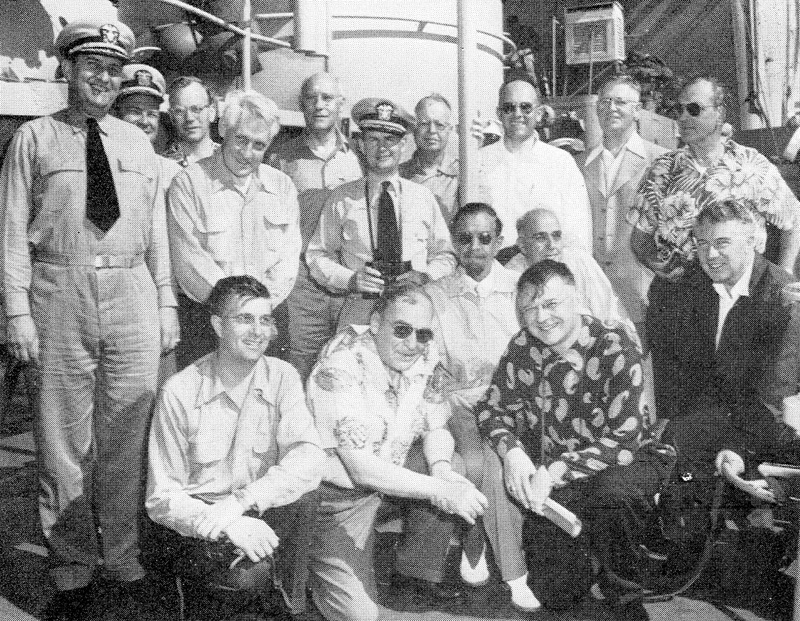
| JOHNSON COUNTY IAGenWeb Project |
Copyright 2003
By Bob Hibbs
Saturday
November 29, 2003
Saturday Postcard 222: Thanksgiving on the Battleship Iowa

University
of Iowa President Virgil Hancher (seated far right) and Iowa historian
William J. Petersen (kneeling at right) were among 14 Iowans who spent
Thanksgiving 1951
aboard the USS Iowa on a shakedown cruise from Long Beach to Pearl
Harbor.
Dinner was traditional turkey, oyster dressing and candied sweet potatoes.
|
By
Bob Hibbs
Thanksgiving
a half-century ago found University of Iowa President Virgil Hancher and Iowa
City’s Bill Petersen cruising the Pacific between Long Beach and Pearl
Harbor aboard the U.S. Navy’s most powerful battleship, the USS Iowa.
They
were among 14 Iowans invited to join the shakedown cruise after the Iowa had
been refurbished and recommissioned at San Francisco for the Korean War.
Adm. Chester Nimitz gave the commissioning address, and the wife of
Iowa Gov. William Beardsley presented the ship its new state flag.
Originally
launched in 1943, the Iowa carried nine 16-inch guns which had blasted
Japanese cities from miles off shore as World War II drew to a close. At 887
feet, she was nearly the length of three football fields. At 108 feet wide,
she is the broadest ship ever to pass through the Panama Canal.
She
carried U.S. President Franklin Roosevelt to a World War II summit in Tehran,
and afterwards was referred to as Roosevelt’s personal battleship. Roosevelt
was an avid sailor.
The
Iowa stood by in Tokyo Harbor in 1945 as the Japanese surrender was accepted
on her twin sister, the USS Missouri, named for the home state of the U.S.
president at the time, Harry Truman.
This
Iowa was the fourth to carry the state’s name, dating to the Civil War era.
That first one was a twin-screw sloop originally named the Ammonoosuc, built
in Boston in 1864. The 335- footer, only one-third the length of the fourth
Iowa, received her Iowa name in 1869, then was mothballed in Boston from 1870
to 1883 and retired.
The
second came into service in 1896 at Philadelphia, one of seven such ships
built prior to the Spanish-American War. This 360-foot rig was stationed off
Cuba at the time her sister ship the USS Maine exploded and sank, bringing on
that war.
After
a brief battle, surrender was affected aboard the Iowa from the Spanish
captain of one of the offending ships. Then, after 20 uneventful years, that
second Iowa became target practice for the new Mississippi battleship, which
sunk her in 1923. She carried six 13-inch guns.
The
third Iowa was under construction in 1922 when terms of a new treaty limited
naval armament. The unfinished hull also became a floating target.
The
fourth Iowa, the largest of her type ever built, is a mighty product of the
industrial age during which sails have given way to steam, coal to fuel oil
and a few relatively small guns to the 16-inch monsters aboard the 1943
Battleship Iowa.
An
original 1943 crew of 2,700 operated her 36-foot draft using 115,000 horse
power to move her 57,600 loaded displacement. In addition to the big guns,
they also operated 20 five-inch guns, and an array of smaller anti-aircraft
weapons.
In
1951, from Sunday, Nov. 18, through Saturday, Nov. 24, Hancher and Petersen
joined Fred Maytag of Newton, Craig Sheaffer of Fort Madison, Fred Hubbell and
E.T. Meredith Jr. of Des Moines, B.J. Palmer of Davenport and seven other
Iowans in a privileged voyage few civilians experience.
In
his summary, Petersen as longtime superintendent of the State Historical
Society wrote in the March 1952 Palimpsest magazine: “We were all amazed
with everything we saw, from the up-to-date laundry to the three shoe cobblers
who put on 650 pairs of heels and 250 soles monthly.”
Medical
staff and care available aboard ship impressed Hancher.
Battleship
Iowa was recommissioned again in 1984 and saw action in Middle East during
1987 and ’88. She set a record in 1989 by blasting a shell the size of a
small car 24 miles to target. Decommissioned in 1990, she’s currently docked
near her new base in San Francisco Bay, destined to become a museum.
Perhaps
that’s a noble end for all ships of war.
Next
Saturday: The Coldren Opera House. Bob Hibbs collects local postcards and researches history related to them.
|